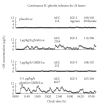Integrating GHS into the Ghrelin System
- PMID: 20798846
- PMCID: PMC2925380
- DOI: 10.1155/2010/879503
Integrating GHS into the Ghrelin System
Abstract
Oligopeptide derivatives of metenkephalin were found to stimulate growth-hormone (GH) release directly by pituitary somatotrope cells in vitro in 1977. Members of this class of peptides and nonpeptidyl mimetics are referred to as GH secretagogues (GHSs). A specific guanosine triphosphatate-binding protein-associated heptahelical transmembrane receptor for GHS was cloned in 1996. An endogenous ligand for the GHS receptor, acylghrelin, was identified in 1999. Expression of ghrelin and homonymous receptor occurs in the brain, pituitary gland, stomach, endothelium/vascular smooth muscle, pancreas, placenta, intestine, heart, bone, and other tissues. Principal actions of this peptidergic system include stimulation of GH release via combined hypothalamopituitary mechanisms, orexigenesis (appetitive enhancement), insulinostasis (inhibition of insulin secretion), cardiovascular effects (decreased mean arterial pressure and vasodilation), stimulation of gastric motility and acid secretion, adipogenesis with repression of fat oxidation, and antiapoptosis (antagonism of endothelial, neuronal, and cardiomyocyte death). The array of known and proposed interactions of ghrelin with key metabolic signals makes ghrelin and its receptor prime targets for drug development.
Figures








Similar articles
-
Cardiovascular actions of the ghrelin gene-derived peptides and growth hormone-releasing hormone.Exp Biol Med (Maywood). 2011 May 1;236(5):505-14. doi: 10.1258/ebm.2011.010365. Epub 2011 Apr 8. Exp Biol Med (Maywood). 2011. PMID: 21478211 Review.
-
Biologic activities of growth hormone secretagogues in humans.Endocrine. 2001 Feb;14(1):87-93. doi: 10.1385/ENDO:14:1:087. Endocrine. 2001. PMID: 11322506 Review.
-
Ghrelin and synthetic growth hormone secretagogues are cardioactive molecules with identities and differences.Semin Vasc Med. 2004 May;4(2):107-14. doi: 10.1055/s-2004-835367. Semin Vasc Med. 2004. PMID: 15478030 Review.
-
Ghrelin and growth hormone secretagogues, physiological and pharmacological aspect.Curr Drug Discov Technol. 2009 Mar;6(1):34-42. doi: 10.2174/157016309787581048. Curr Drug Discov Technol. 2009. PMID: 19275540 Review.
-
Growth hormone-dependent regulation of pituitary GH secretagogue receptor (GHS-R) mRNA levels in the spontaneous dwarf Rat.Neuroendocrinology. 1998 Nov;68(5):312-8. doi: 10.1159/000054379. Neuroendocrinology. 1998. PMID: 9822798
Cited by
-
Ghrelin augments murine T-cell proliferation by activation of the phosphatidylinositol-3-kinase, extracellular signal-regulated kinase and protein kinase C signaling pathways.FEBS Lett. 2014 Dec 20;588(24):4708-19. doi: 10.1016/j.febslet.2014.10.044. Epub 2014 Nov 18. FEBS Lett. 2014. PMID: 25447526 Free PMC article.
-
A Linear Fragment of Unacylated Ghrelin (UAG6-13) Protects Against Myocardial Ischemia/Reperfusion Injury in Mice in a Growth Hormone Secretagogue Receptor-Independent Manner.Front Endocrinol (Lausanne). 2019 Jan 11;9:798. doi: 10.3389/fendo.2018.00798. eCollection 2018. Front Endocrinol (Lausanne). 2019. PMID: 30692964 Free PMC article.
-
Strong Positive Correlation between TSH and Ghrelin in Euthyroid Non-Growth Hormone-Deficient Children with Short Stature.Molecules. 2020 Aug 27;25(17):3912. doi: 10.3390/molecules25173912. Molecules. 2020. PMID: 32867237 Free PMC article.
-
The Anti-apoptotic Effect of Ghrelin on Restraint Stress-Induced Thymus Atrophy in Mice.Immune Netw. 2016 Aug;16(4):242-8. doi: 10.4110/in.2016.16.4.242. Epub 2016 Aug 23. Immune Netw. 2016. PMID: 27574503 Free PMC article.
-
Role of endogenous cortistatin in the regulation of ghrelin system expression at pancreatic level under normal and obese conditions.PLoS One. 2013;8(2):e57834. doi: 10.1371/journal.pone.0057834. Epub 2013 Feb 28. PLoS One. 2013. PMID: 23469081 Free PMC article.
References
-
- Bowers CY, Chang J, Momany F, Folkers K. Effect of the enkephalins and enkephalin analogs on release of pituitary hormones in vitro. In: MacIntyre I, Szelke M, editors. Molecular Endocrinology. Amsterdam, The Netherlands: Elsevier/North Holland; 1977. pp. 287–292.
-
- Davenport AP, Bonner TI, Foord SM, et al. International Union of Pharmacology. LVI. Ghrelin receptor nomenclature, distribution, and function. Pharmacological Reviews. 2005;57(4):541–546. - PubMed
-
- Kojima M, Hosoda H, Date Y, Nakazato M, Matsuo H, Kangawa K. Ghrelin is a growth-hormone-releasing acylated peptide from stomach. Nature. 1999;402(6762):656–660. - PubMed
-
- Veldhuis JD, Roemmich JN, Richmond EJ, Bowers CY. Somatotropic and gonadotropic axes linkages in infancy, childhood, and the puberty-adult transition. Endocrine Reviews. 2006;27(2):101–140. - PubMed
-
- Howard AD, Feighner SD, Cully DF, et al. A receptor in pituitary and hypothalamus that functions in growth hormone release. Science. 1996;273(5277):974–977. - PubMed
Grants and funding
LinkOut - more resources
Full Text Sources
